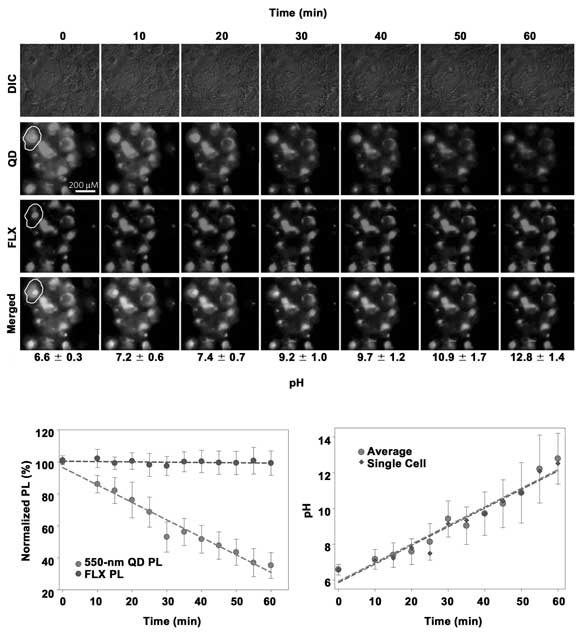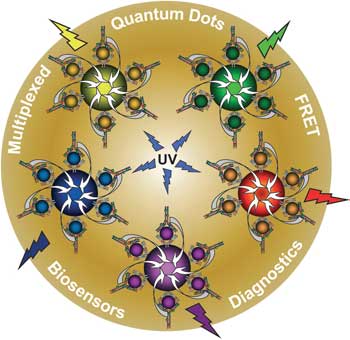
Multiplexed Sensing with QD-based FRET
For more than a decade, investigators have explored the potential
of quantum dot (QD)-based Förster resonance energy transfer (FRET) for multiplexed
diagnostics, noting the unique photophysical properties of QDs. This technique has
not yet emerged into the realm of clinical application, but thanks to the efforts
of several groups, it is moving closer to that goal.
Quantum dot-based FRET has several advantages
for multiplexed diagnostics, including the size-tunability of QDs as well as their
broad absorption spectra and narrow emission bands, high brightness, high quantum
yields and photostability.
But there are disadvantages, too. Some are unavoidable, as University
of Paris researcher Niko Hildebrandt noted in a recent ACS Nano perspective paper,
citing as an example QDs’ relatively large size, which could affect the behavior
of small biomolecules. Others, including instability in biological media, could
be addressed through careful investigation. Still others, such as blinking effects,
might be turned into advantages.
Investigators are working to develop high-performance methods
and technologies to exploit the advantages of quantum dots for multiplexed diagnostics
and other applications. Hildebrandt and colleagues, for example, have reported the
use of QDs as FRET acceptors, rather than as donors, the more conventional use of
QDs in FRET.

Medintz and colleagues
also are exploring the use of quantum dots in electron-transfer (as opposed to FRET)-based
sensing. Shown are differential interference contrast and fluorescent micrographs
of COS-1 cells microinjected with 550-nm-emitting QD-dopamine conjugates and FLX
nanospheres in PBS at pH 6.5, with merged images shown in the bottom row. Courtesy
of Nature Materials.
In their recent work, they have paired QD acceptors with luminescent
terbium complexes serving as donors. This offers several advantages, Hildebrandt
said, including large Förster distances, the almost complete suppression of
background (resulting from the long luminescence lifetimes of the terbium donors),
leading to very high sensitivity and the use of only one terbium donor for several
QD acceptors. This work was initially reported in a pair of papers in 2010, in Angewandte
Chemie International Edition.
Developing the approach has required a significant investment
of time, but otherwise the researchers have not encountered any major unanticipated
obstacles. “It took us quite a while until we had the first proof of FRET
to QD acceptors,” Hildebrandt said, “because you really need the long
lifetimes of the donors to get an efficient FRET.” This in addition to the
“usual trial-and-error and optimization steps that you need for most new approaches
that no one else has done before.” Once the system was properly optimized,
however, there were no major challenges beyond those typically associated with QD-based
FRET.

Researchers are working to develop QD-based FRET for multiplexed diagnostics and other applications. In Paris, Niko Hildebrandt and colleagues have reported the use of quantum dots
as FRET acceptors – rather than as donors, as is typically done – and
have shown that this can offer advantages over more conventional approaches. Courtesy
of Angewandte Chemie International Edition.
The next step is to develop the approach for clinical application.
The researchers have demonstrated a proof-of-principle bioassay with biotin and
streptavidin. To perform real-world diagnostics, however, they must label the quantum
dots and terbium complexes with antibodies, aptamers, DNA/RNA or other biological
recognition molecules. They are working to achieve this.
They also are exploring other possible applications of QD-based
FRET. Alongside several partners in a European project called Nanognostics, Hildebrandt’s
group is seeking means for early detection of Alzheimer’s disease. At the
same time, they are looking into the potential of FRET biosensing for cellular investigations
– detecting rare cells such as circulating tumor cells, for example, or investigating
biological processes inside and outside the cells.
Sensing inside the cell
Among other promising uses, QD-based FRET could be applied to
intracellular sensing. In a 2009 review in Physical Chemistry Chemical Physics,
Igor L. Medintz and Hedi Mattoussi, both scientists at the US Naval Research Laboratory
(NRL) in Washington, noted that the technique could shed light on a number of biological
processes occurring inside live cells, including protein interactions, enzymatic
activity and ion fluxes in response to external stimuli. In addition, they said,
multiplexed FRET inside cells could offer insight into how cellular processes are
correlated.

Igor L. Medintz and colleagues at the US Naval Research Laboratory
have made strides toward intracellular sensing with QD-based FRET. Shown are images
of COS-1 cells microinjected with 550-nm-emitting QDs labeled with a Texas Red dye
acceptor on a peptide and engaged in FRET. In these images, QDs are being excited
and are sensitizing the proximal Texas Red acceptor. The three images are a differential
interference contrast image of the cells (left), the isolated QD emission (center)
and the isolated QD-sensitized Texas Red acceptor emission (right). Courtesy of
US Naval Research Laboratory.
Several research groups, including Hildebrandt’s at the
University of Paris, are working to develop QD-based FRET for such applications.
Although some progress has been made toward intracellular sensing with QD-based
FRET, “we’re not quite there yet,” Medintz said. “The FRET
part itself is very efficient; the hard part still remains the chemistry needed
for assembling the QD FRET constructs and reliably delivering them where needed
inside a cell.”
In an ACS Nano paper published July 26, eBiosciences of San Diego,
in conjunction with the NRL group, reported two new orthogonal nanocrystal bioconjugation
chemistries that overcome many of the issues that plague currently used methods.
The chemistries target, respectively, the ever-present amines found on proteins
and thiols present in antibody hinge regions or introduced recombinantly into other
proteins to aid in site-specific labeling. They demonstrated the multiplexing potential
of these new QD chemistries in a variety of applications, including three-color
immunoassays and five-color immunolabeling in cellular and tissues samples, among
others.
Medintz and colleagues at NRL also have published a series of
papers exploring delivery of quantum dots into cells. In 2010, they demonstrated
an important step toward engineering QD FRET constructs intracellularly. They showed
that specifically targeted proteins could be bioconjugated to QDs inside live cells.
This opens the door to having cells presynthesize the protein portion of the sensor,
which would provide the recognition or catalytic activity and await final assembly
on the QD intracellularly.
To support their work with intracellular sensing, the scientists
also have been seeking to understand how QDs and other nanoparticles engage in different
forms of energy transfer. In a Nature Materials paper published last year, for example,
they showed that QD-dopamine bioconjugates can function as pH-based sensors –
based not on FRET but rather on electron transfer. This suggests the intriguing
possibility of having several QD sensors functioning simultaneously inside the same
cell while signaling by different processes such as FRET and electron transfer.
“We are interested in applying the QDs as either FRET or
electron transfer donors and/or acceptors,” Medintz said. “This, of
course, is predicated on a full understanding of the underlying energy transfer
processes, and so requires a lot of basic research in making the QD assemblies and
then looking at their photophysical and energy transfer interactions before we even
get to the biosensing aspect.”
Published: September 2011